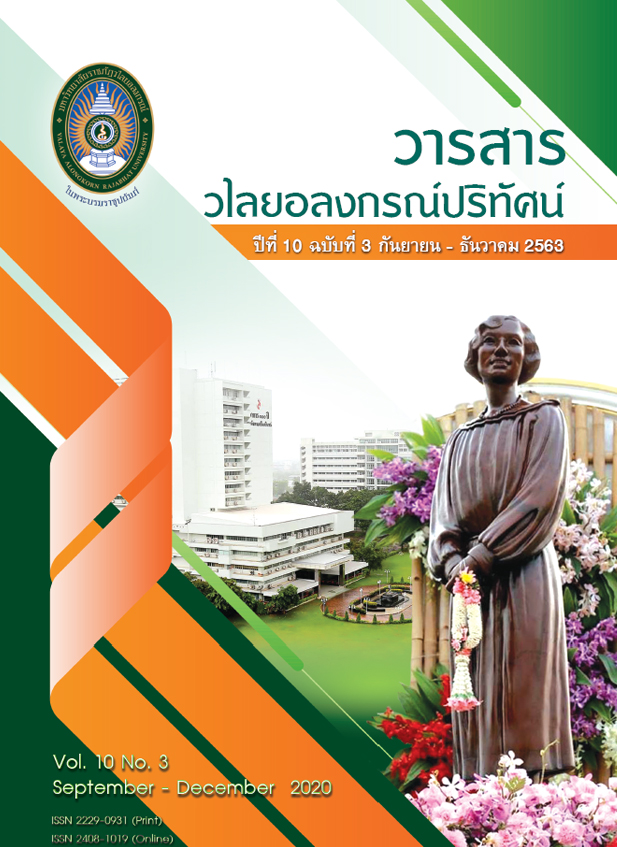แนวทางการพัฒนาการท่องเที่ยวอย่างยั่งยืน กรณีศึกษา ชุมชนบ้านห้วยหญ้าเครือ อำเภอน้ำหนาว จังหวัดเพชรบูรณ์
คำสำคัญ:
การท่องเที่ยวอย่างยั่งยืน, การมีส่วนร่วมของชุมชน, ชุมชนบ้านห้วยหญ้าเครือบทคัดย่อ
งานวิจัยนี้มีวัตถุประสงค์เพื่อ 1) ศึกษาบริบทด้านการท่องเที่ยวชุมชนบ้านห้วยหญ้าเครือ 2) ศึกษาการมีส่วนร่วมด้านการท่องเที่ยวของคนในชุมชนบ้านห้วยหญ้าเครือ และ 3) เสนอแนะแนวทางการพัฒนาการท่องเที่ยวอย่างยั่งยืนชุมชนบ้านห้วยหญ้าเครือ อำเภอน้ำหนาว จังหวัดเพชรบูรณ์ ซึ่งใช้วิธีการดำเนินการวิจัยเชิงคุณภาพ ที่ประกอบไปด้วยการศึกษาข้อมูลด้านเอกสาร การสังเกต และการสัมภาษณ์เชิงลึก โดยมีการตรวจสอบความเที่ยงตรงโดยผู้ทรงคุณวุฒิ ใช้วิธีการคัดเลือกแบบเฉพาะเจาะจง ซึ่งประกอบด้วยผู้ให้ข้อมูลหลัก จำนวน 5 กลุ่ม ได้แก่ หน่วยงานภาครัฐ ผู้นำชุมชนและผู้นำกลุ่มท่องเที่ยว คนในชุมชนบ้านห้วยหญ้าเครือ ผู้ประกอบการในพื้นที่อำเภอน้ำหนาว และนักท่องเที่ยว รวมทั้งสิ้นจำนวน 15 คน แล้วนำประเด็นที่ได้จากการรวบรวมข้อมูลมาวิเคราะห์ด้วยวิธีการวิเคราะห์เชิงเนื้อหา
ผลการวิจัยพบว่า 1) บริบทชุมชนบ้านห้วยหญ้าเครือ มีความโดดเด่นในด้านทรัพยากรการท่องเที่ยวเชิงธรรมชาติ จุดชมวิว การจัดกิจกรรมท่องเที่ยว อีกทั้งยังสามารถเชื่อมโยงไปยังแหล่งท่องเที่ยวอื่น ๆ ได้อีกหลากหลายแห่ง 2) ชุมชนให้ความสำคัญกับการเข้าร่วมกิจกรรมและมีส่วนร่วมในการรักษาทรัพยากรการท่องเที่ยวในชุมชนเป็นอย่างดี แต่ในด้านการบริหารจัดการและการกระจายรายได้ยังคงเป็นปัญหาหลักของชุมชน ดังนั้นเพื่อการนำไปสู่การพัฒนาการท่องเที่ยวอย่างยั่งยืนของชุมชน จึงต้องคำนึงถึงการพัฒนากิจกรรมท่องเที่ยวที่มีส่วนช่วยอนุรักษ์ทรัพยากรการท่องเที่ยว สร้างจิตสำนึกที่ดี ประสบการณ์ที่มีคุณค่าแก่นักท่องเที่ยว และจะต้องคงไว้ซึ่งเอกลักษณ์ของชุมชน ทั้งนี้หน่วยงานภาครัฐควรเป็นตัวกลางในการพัฒนากิจกรรมการท่องเที่ยว การกระจายรายได้และผลประโยชน์อย่างเท่าเทียม จึงกล่าวได้ว่าการมีส่วนร่วมของชุมชนและผู้มีส่วนได้เสียทั้งหมดเป็นกระบวนการสำคัญที่จะนำไปสู่การท่องเที่ยวอย่างยั่งยืนได้สำเร็จ
เอกสารอ้างอิง
กรกนก เกิดสังข์. (2560). การพัฒนาการท่องเที่ยวอย่างยั่งยืนเชิงกลยุทธ์: กรณีศึกษาตำบลบางใบไม้ อำเภอเมือง จังหวัดสุราษฎร์ธานี. วารสารราชภัฏสุราษฎร์ธานี. 4(2): 231-249.
กลุ่มงานยุทธศาสตร์และข้อมูลเพื่อการพัฒนาจังหวัด สำนักงานจังหวัดเพชรบูรณ์. (2563). แผนพัฒนาจังหวัดเพชรบูรณ์ พ.ศ. 2561-2565 (ฉบับทบทวนประจำปี พ.ศ. 2563). [ออนไลน์], เข้าถึงได้จาก: http://www.phetchabun.go.th/download_pmqa/book_file/1568578841_mzxcwnmt.pdf. (2563, 14 มีนาคม).
จันทร์จิรา สุขบรรจง และสมยศ วัฒนากมลชัย. (25562). การพัฒนาการท่องเที่ยวอย่างยั่งยืนของ หนานมดแดง อำเภอป่าพะยอม จังหวัดพัทลุง. Journal of Thai Hospitality and Tourism. 14(2): 3-16.
เทิดชาย ช่วยบำรุง. (2552). บทบาทขององค์กรปกครองส่วนท้องถิ่นกับการพัฒนาการท่องเที่ยวอย่างยั่งยืนบนฐานแนวคิดเศรษฐกิจพอเพียง. [ออนไลน์], เข้าถึงได้จาก: http://www.kpi.ac.th/media_kpiacth/pdf/M10_213.pdf. (2563, 22 พฤษภาคม).
บุญเลิศ จิตตั้งวัฒนา. (2548). การวางแผนพัฒนาการท่องเที่ยวแบบยั่งยืน. เชียงใหม่: คณะมนุษย์ศาสตร์ มหาวิทยาลัยเชียงใหม่.
ปิยะพร คำแข. (2563). ชาวบ้านชุมชนห้วยหญ้าเครือ. สัมภาษณ์, 16 กุมภาพันธ์ 2563.
พยอม ธรรมบุตร. (2549). การวางแผนยุทธศาสตร์ ด้านการท่องเที่ยว, เอกสารประกอบการเรียนการสอน เรื่อง การวางแผนยุทธศาสตร์ ด้านการท่องเที่ยว. กรุงเทพฯ: สถาบันพัฒนาการท่องเที่ยวเชิงอนุรักษ์ มหาวิทยาลัยศรีนครินทรวิโรฒ.
พัชรินทร์ ศรีพุต. (2563). ชาวบ้านชุมชนห้วยหญ้าเครือ. สัมภาษณ์, 16 กุมภาพันธ์ 2563.
พิมพ์ระวี โรจน์รุ่งสัตย์. (2553). การท่องเที่ยวชุมชน. กรุงเทพฯ: โอ.เอส.พริ้นติ้ง เฮ้าส์.
พิมพ์ลภัส พงศกรรังศิลป์. (2557). การจัดการการท่องเที่ยวชุมชนอย่างยั่งยืน: กรณีศึกษา บ้านโคกไคร จังหวัดพังงา. วารสารวิชาการ Veridian E-Journal. 7(3): 650-665.
โยธิน แสวงดี. (2561). การวิจัยเชิงคุณภาพ เอกสารประกอบการเรียนการสอน เรื่อง การออกแบบการวิจัย. กรุงเทพฯ: สถาบันบัณฑิตพัฒนบริหารศาสตร์.
วิภาดา มุกดา. (2557). การมีส่วนร่วมของประชาชนในการจัดการท่องเที่ยวเชิงนิเวศ อำเภออุ้มผาง จังหวัดตาก. วารสารวิชาการบัณฑิตวิทยาลัยสวนดุสิต. 10(3): 55-72.
สาธิต คำเจียก. (2563). ผู้นำกลุ่มท่องเที่ยวโดยชุมชนบ้านห้วยหญ้าเครือ. สัมภาษณ์, 18 กุมภาพันธ์ 2563.
อัจฉรา ศรีลาชัย และภูเกริก บัวสอน. (2561). แนวทางการจัดการรูปแบบการท่องเที่ยวโดยชุมชนอย่างยั่งยืน กรณีศึกษาชุมชนบ้านโคก เมือง ตำบลจรเข้มาก อำเภอประโคนชัย จังหวัดบุรีรัมย์. วารสารบัณฑิตศึกษา มหาวิทยาลัยราชภัฏวไลยอลงกรณ์ ในพระบรมราชูปถัมภ์. 12(1), 218-229.
อุษาวดี พูลพิพัฒน์. (2545). การท่องเที่ยวแบบยั่งยืน: กรณีศึกษาการท่องเที่ยวเชิงนิเวศโดยชุมชนในประเทศไทย. จุลสารการท่องเที่ยว. 21(4): 38-48.
Arif, Y. M., Nugroho, S. M. S., & Hariadi, M. (2019). Selection of Tourism Destinations Priority using 6AsTD Framework and TOPSIS. [Online], Available: https://ieeexplore.ieee.org/document/9034671. (2020, 16 December).
Buhalis, D. (2000). Marketing the competitive destination in the future. Tourism Management. 21(1), 97-116.
Buhalis, D. (2014). Smart Tourism Destination. Information and Communication Technologies in Tourism 2014. [Online], Available: https://link.springer.com/chapter/10.1007/978-3-319-03973-2_40. (2020, 16 December).
The Global Sustainable Tourism Council. (2013). Global Sustainable Tourism Council Criteria. [Online], Available: https://www.gstcouncil.org/wp-content/uploads/ 2017/01/ Thai-GSTC---H_TO-v2.pdf. (2019, 20 August).
ดาวน์โหลด
เผยแพร่แล้ว
รูปแบบการอ้างอิง
ฉบับ
ประเภทบทความ
สัญญาอนุญาต
ข้อความที่ปรากฏในบทความแต่ละเรื่องในวารสารวไลยอลงกรณ์ปริทัศน์ เป็นความคิดเห็นของผู้นิพนธ์แต่ละท่าน มิใช่เป็นทัศนะและมิใช่ความรับผิดชอบของกองบรรณาธิการจัดทำวารสาร และ
มหาวิทยาลัยราชภัฏวไลยอลงกรณ์ ในพระบรมราชูปถัมภ์


